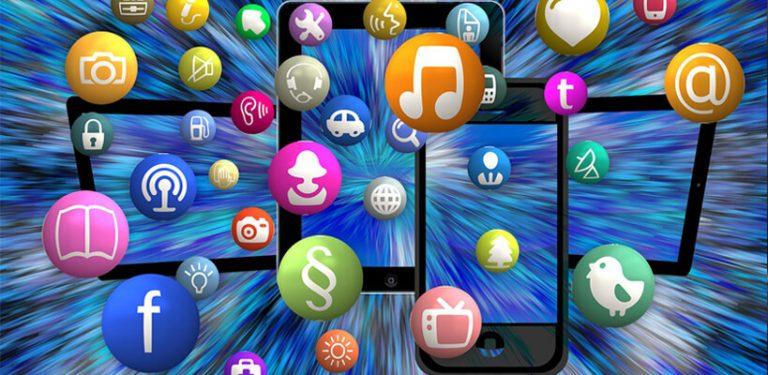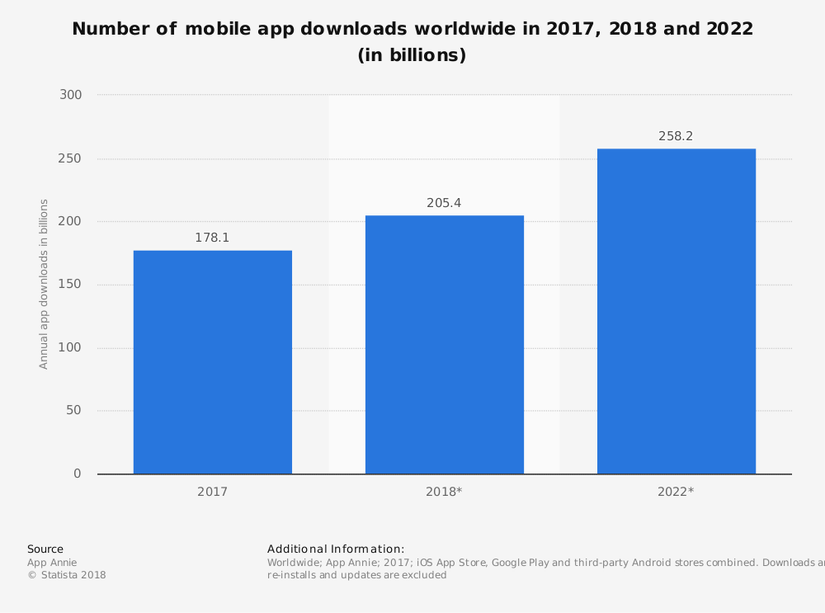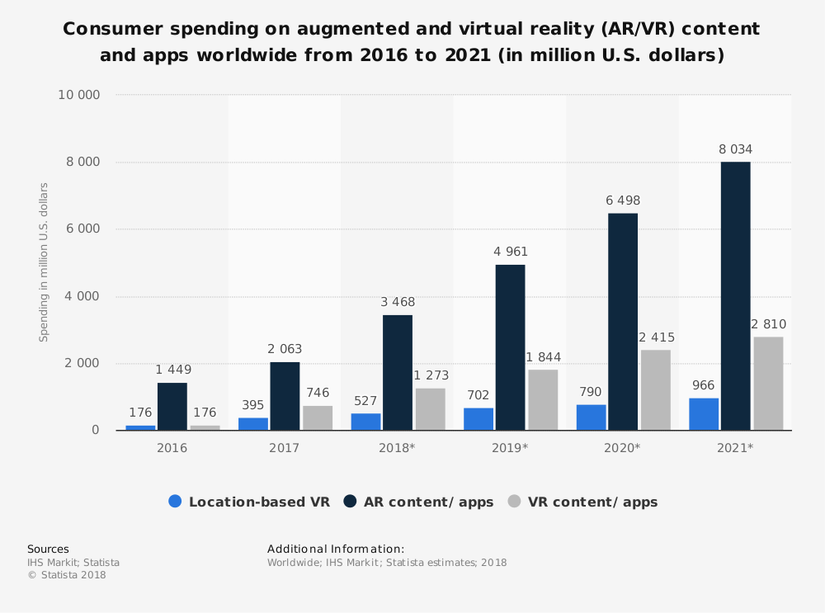Exploring the Future of Mobile App Development
Bài đăng này đã không được cập nhật trong 7 năm

From phones to cars to medicines, technology touches every part of our lives. If you can create technology, you can change the world.” ~Susan Wojcicki, CEO of YouTube
The birth of gadgets like smartphone, tablets, smartwatches has led to an explosion of developers and freelancers working in the mobile app development industry. Mobile App Development Industry is continuously broadening and emerging.
According to recent statistics, it is clear that there are more than 2.5 billion smartphones in the world and this figure is likely to reach 2.87 billion by 2020.
In 2017, there were 178.1 billion downloads of apps worldwide and this figure is projected to reach 258.2 billion in 2022. Mobile app development is certainly witnessing active growth every year.

Right now the app industry is being dominated by social media and gaming apps. Apps, be it an iOS app or an Android app, have become a necessity for all mobile users.
With apps becoming such a significant part of everyone’s life, it is easy to wonder about the future that lies in store for mobile apps. The fact is that mobile apps, like any other technology, will be driven by advancements.
Below are some trending technologies which will make a revolution in Mobile application development.
Internet of Things and Mobile-connected Smart Objects
Mobile application development is not only limited to the smartphones. Presently and in the future, the mobile application will control and manage the gadgets and devices which are around us.
Internet of Things (IoT) will be the mainstream from the education sector to the healthcare sector and from smart offices to smart homes. Mobile App Development for IoT will lead to a greater control over a range of physical objects.
With the rise of the Internet of Things, users will be able to take control over their daily routines and tasks with the help of apps.
According to researcher prediction, it shows that the IoT market will grow from $157.05 billion in 2016 to $661.74 billion by 2021, at CAGR (Compound Annual Growth Rate) of 33.3%. It will directly impact the mobile app development trends as IoT devices are controlled by smartphones.
Wearable Devices
Currently, wearable devices are still mostly a gimmick. Few of these devices are actually worth using but still, wearable devices are selling rapidly.
As technology improves, it is certain to be more of these devices and they will also be of a better quality. This brings forward a new opportunity for mobile app developers.
After all, apps will be required to make the best use of the features being offered by these devices.
Smart wearable devices like Apple Watch and Google Lens shows an upcoming change in the computing and the transition from basic to smart wearables.
This will opens new doors for the developers, vendors and accessory makers. It will help them to enable a wide range of product in areas such as healthcare, fitness, sports, and fashion.
This wearable device will be connected with smartphones and this influence the next generation of mobile application development strategies.
Augmented Reality/Virtual Reality Apps
In coming years AR and VR will go beyond entertainment and gaming. Augmented Reality will primarily focus on the enterprise market for engineering, retail, real estate, and healthcare.
Games like Pokemon Go, iOnRoad, Sky Siege and myNav are bright examples of AR games.
Virtual Reality will be more focused on the game and entertainment like Samsung Gear VR, Google Cardboard, and Oculus Rift.
Both AR and VR possess huge potential when it comes to transforming a diverse range of industry sectors.

Benefits of Augmented Reality (AR)
- It will help you to present your product in detail with the help of a visual experience for your user.
- This technology will help us to train the employee in a high-tech way, which will increase productivity.
- Companies can show their audience the relevance of their products in real-time.
Benefits of Virtual Reality (VR)
- Allow product showcasing in virtual showrooms without using much space
- Enables promoting of products using a blend of photography and technology, which makes processes more interactive.
- Could be used for company branding and aggressive marketing.
- Provides a 3D vision of products.
Innovation in Mobile User Experience
User experience has always been a priority in developing mobile apps. However, going forward, an app development company will need to think up innovative solutions for displaying content in a more effective manner.
The designs have to be intuitive and the interfaces must be interactive. Solutions have to be found for unique mobile challenges such as constant user interruption and partial user attention.
These are certainly the challenges down the road for mobile apps. However, it is by overcoming those challenges that developers can make mobile apps better.
Apps might be an important part of people’s lives at the moment. It is highly possible that they can become inseparable aspects of life in the future.
For businesses, there is no better time to invest in iOS app development or Android app development.
Increasing M-Commerce Opportunities
Statistics show that the number of e-commerce sales being made via a mobile device is on an increase.
This trend is certainly going to gain ground in the future as more consumers start making use of m-commerce.
Additionally, the availability of mobile payment gateways such as Google Wallet and Apple Pay is certainly going to make it easier for purchases to be made with a smartphone.
Apps will now have to start integrating payment capabilities that allow transactions to take place without a card or cash and it should be coupled with the wearable devices. Beyond this, wearable devices will also play an important role in the future of mobile payment and customer loyalty.
Motion and Location Sensing
In today’s technology, most of the smartphone have location and motion sensing capabilities.
As in our day-to-day activities whether it can be calling online Cab Service or it can be accessing Google Map which has various positioning methods to provide different granularities of location data.
Motion sensing features are mostly used in security, power-saving, Anti-theft, and games. In coming days we will see a rise in Motion Sensing and Location Sensing apps as its demand will rise in user as well as the enterprise domain.
Mobile Security Apps
As smartphones are becoming more important to us and our dependency on them increases for accessing bank applications and other private data, security of a smartphone become more crucial than ever because of the amount of data it contains.
An application which has built-in security features can make a huge change in the mobile application market.
Developers adopting these features in their development provides better UX with more security features. With new programming languages, we will see more secure applications in the market.
The mobile application developer will be working harder to ensure every app they design comes with the guarantee of the safety.
Artificial Intelligence
Artificial Intelligence has made a mark on both the construction technique of mobile apps and in boosting their capabilities.
By using advanced analytics, the cognitive interface into a complex system, and machine learning techniques, business users now have more powerful insights which were never available to them.
Original Article and more insights available at our mobile app development blog.
All rights reserved